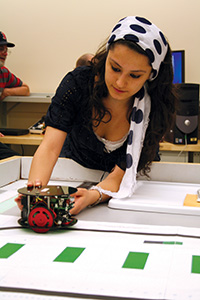
During finals week, while most students are taking exams, one class will be taking a different approach — playing soccer, robot-style.
Students of Professor Richard Eckert’s Microcontrollers and Robotics computer science class will compete in RoboSoccer. The game will be played by the Open Robot, a wireless mobile robot designed by Binghamton University alumnus Abe Howell.
Each team of students will program the Open Robot’s radio frequency antenna, two light sensors, five infrared transmitters and one micro-controller chip to score goals.
Before each game of RoboSoccer, two Open Robots are placed inside individual boxes containing radio frequency identification chips. The first robot to locate the chip in its playing area becomes the offensive player, and the other becomes the defensive player.
“Students have to come up with an algorithm to systematically [have the robot] search the pre-game area,” Eckert said.
Goals are scored when an offensive robot moves into a goal zone at the end of a square playing field. Robots navigate into the area with the help of their light sensors, as a white light is placed behind the goal zone. However, scoring a goal is no easy task, as the robot on offense must evade the defending robot by transmitting infrared signals.
If the defensive robot bumps into the offensive robot, they switch roles.
“Students must program their Open Robots so its infrared sensors determine how far away the other robot is and how far away the walls of the playing area are,” Eckert said. “It’s a very sophisticated program the students are going to be writing.”
The micro-controller chip in each robot contains firmware that moves the robot’s two wheels.
“The firmware can send a command to the robot to move it five rotations forward or backward, for example,” Eckert said.
Students can choose to program movements into the firmware, or program their own complex navigation system on a computer with languages such as C++ or C#. Each command from a computer program is transmitted to the robot through Wi-Fi signals.
“As we progressed through the course, we’ve gotten to work with more sophisticated robots that can interpret more commands,” said Nick Drohan, a senior computer science major enrolled in the class.
The robot with the most goals after three minutes wins the match.
James Harrison, a senior computer science and bioengineering major who is also in the class, said he thinks the competitive nature of the project forces students to think differently when programming.
“It’s not like you’re going through the motions to make something work,” he said. “You’re trying to achieve something better than everyone else.”
Howell designed the Open Robot in 2003 for his doctorate when the University received a course, curriculum and laboratory grant from the National Science Foundation for a bioengineering course designed after a custom robot.
Over the past six years Howell added the radio frequency antenna, Wi-Fi support and less expensive parts to improve the robot’s efficiency.
His changes haven’t gone unnoticed, as Dongguk University in South Korea is currently using the robots for health-monitoring research.
“The things that they can do are amazing,” Ryan Zielinski, a teaching assistant for the class, said.
Eckert held his first RoboSoccer competition at BU in 2002, with this year being the first time Howell’s Open Robots will be used for the competition.
Previously, the Open Robot was used in Eckert’s classes for different projects, such as navigating an obstacle course or finding chips in an Easter egg hunt.


